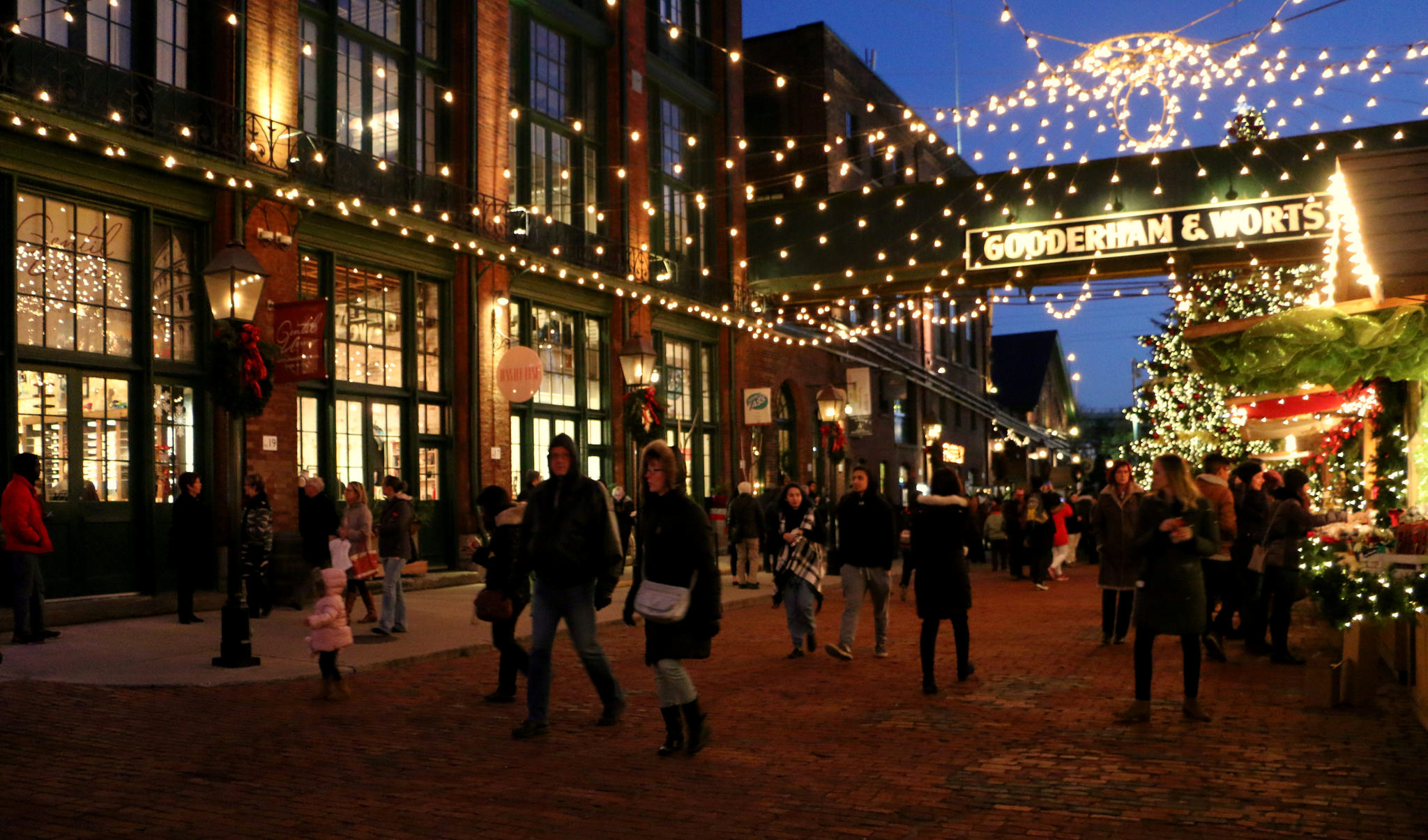
Once home to the largest distillery in the British Empire, Toronto's restored District features the best-preserved collection of Victorian Industrial Architecture. It's a stunning backdrop for the local restaurants, design stores, cafés and art galleries.
THE HISTORY OF THE DISTILLERY DISTRICT
The Gooderham and Worts Distillery was founded in 1832. Once providing over 7.6 million litres (2 million gallons) of whisky, mostly for export on the world market, the company was bought out in later years by rival Hiram Walker Co., another large Canadian distiller. Its location on the side of the Canadian National Railway mainline and its proximity to the mouth of the original route of the Don River outlet into Lake Ontario created a hard edge which separated the district from neighbouring communities. These did, however, allow for a transport connection to the rest of Canada and the world, and helped Toronto to be dominant as an industrial centre and shipping hub.
With the deindustrialization of the surrounding area in the late 20th century, and the winding-down of the distillery operations, the district was left increasingly derelict. Surrounding industrial and commercial buildings and structures were often demolished, leaving the former distillery surrounded primarily by empty lots. The closing of the remaining distillery operations in 1990 created redevelopment and investment opportunities for a district that contained the largest and best preserved collection of Victorian-era industrial architecture in North America. The Distillery District was designated as a National Historic Site, and has been protected under the Ontario Heritage Act since 1976. It was listed by National Geographic magazine as a "top pick" in Canada for travelers.
The economic recession of the early 1990s, however, and the resulting crash in residential condominium prices and office lease rates in downtown Toronto, delayed efforts to revitalize the district. Despite this, two residential condominium buildings were constructed on the periphery of the district during the late 1990s.
While the site awaited redevelopment and reinvestment, the district's ambiance began to attract numerous film shoots. Since 1990, the site has served as a location for over 800 film and television productions.
THE DISTILLERY DISTRICT TODAY
In 2001, the site was purchased by Cityscape Holdings Inc., which transformed the district into a pedestrian-orientated area. Work was completed and the district reopened to the public by 2003. The new owners refused to lease any of the retail and restaurant space to chains or franchises, so the majority of the buildings are occupied with boutiques, art galleries, restaurants, jewelry stores, cafés, and coffeehouses. The upper floors of a number of buildings have been leased to artists as studio spaces and to office tenants with a "creative focus". There is ongoing development of residential condominiums, offices, and more retail space on the vacant lands that surround the district.
The Distillery District's traditional brick-paved streets and lanes are restricted to pedestrians and cyclists, with general motor vehicle traffic restricted to streets and parking areas outside of the district's historic centre. Several large sculptures installed along the lanes enliven its streetscapes, three being on Distillery Lane and the final one at the parking area at the end of Trinity Street. Another primary landmark is the chimney stack atop the Boiler House complex. There are informal public spaces on the pedestrianized streets with chairs and tables for general use, as well as patios for some of its coffee houses and restaurants.
Trinity Street is the widest street in the district and often functions as a public square for events such as market days. The four borders of the Distillery District are Parliament Street to the West, Mill Street to the North, Cherry Street to the East, and the parking area to the South with the condominiums along Distillery Lane forming hard edges to pedestrians.
Toronto's Official Plan designates the Distillery District as a mixed-use land parcel, which is an area that includes a combination of land uses such as commercial, residential, entertainment facilities and art galleries. In order to provide additional details regarding the breakdown of the types of mixed uses in the area, the King-Parliament Secondary Plan is used to determine the locations of the commercial, residential, and other land uses.
DISTILLERY DISTRICT REAL ESTATE
Condos are literally the only option in the Distillery District, and in the contrast to the rest of downtown Toronto, there really aren’t that many around. While most of the lofts, apartments and townhouses of the Distillery District are small, many will offer stellar views of super trendy streetscapes or even of the shoreline. Penthouses, on the other hand, are in no short supply, but tend to be quite expensive, whether you're renting or buying. The Distillery District has a little bit of almost everything except for family-style houses with yards.
The Distillery District is perfect for trend-conscious hipsters or young urbanites who will love the marriage of industrial, downtown, modern and historical architecture. The Distillery District is not good for families. There are few kids in the neighbourhood, partly due to the small spaces offered in the lofts and apartments of the Distillery District. Seniors will similarly find themselves without neighbours of a similar age. Those with tight budgets will be priced out of the market.
Looking for the best of The Distillery District?
Parks
Schools
Please click here for a comprehensive list of schools in The Distillery District.
Restaurants
El Catrin: Trendy, stylish restaurant with elevated Mexican small plates, many tequilas and a heated patio.
Cluny Bistro: Huge modern French bistro with updated classic fare and Gallic feel, from marble bar to tiled floors.
Madrina Bar y Tapas: Classic and modern Spanish tapas plus sangria and cocktails in a stylish, stone- & wood-accented locale.
Cafés
.CACAO 70: Café offering chocolate desserts (from waffles to fondue) and drinks made with a variety of cocoas.
Arvo Coffee: Comfy, brick-lined hub for artisanal coffee drinks, monthly live music and beans and plants for sale.
Brick Street Bakery: Outpost of a small chain known for its ample menu of sandwiches, savory pies, cookies, bread and more.








